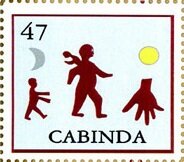Stamp: Flag of the Kakongo Kingdom (Cinderellas 2012)
Flag of the Kakongo Kingdom (Cinderellas 2012)
01 January (Cinderellas ) within release Angola : Cabinda goes into circulation Stamp Flag of the Kakongo Kingdom face value 47 No Face Value
| Stamp Flag of the Kakongo Kingdom in catalogues | |
|---|---|
| Colnect codes: | Col: AO-CB 2012-02/1 |
Stamp is square format.
Cinderella stamp issued by the so-called "Africa Federation of Free States". Denomination is fictitious.Also in the issue Angola : Cabinda:
- Mini Sheet - Anchor face value 8*12;
- Stamp - Anchor face value 12;
- Mini Sheet - Coat of arms face value 8*24;
- Stamp - Coat of arms face value 24;
- Mini Sheet - Coffee and cacao plantation face value 6*48;
- Stamp - Coffee and cacao plantation face value 48;
- Mini Sheet - Duck face value 8*25;
- Stamp - Duck face value 25;
- Mini Sheet - Duck in flight face value 8*25;
- Stamp - Duck in flight face value 25;
- Mini Sheet - Flag of the Kakongo Kingdom face value 8*47;
- Stamp - Flag of the Kakongo Kingdom face value 47;
- Mini Sheet - Lion's head face value 8*18;
- Stamp - Lion's head face value 18;
- Mini Sheet - Map of Africa face value 8*18;
- Stamp - Map of Africa face value 18;
- Mini Sheet - Naval ship face value 8*25;
- Stamp - Naval ship face value 25;
- Mini Sheet - Squirrel face value 8*40;
- Stamp - Squirrel face value 40;
|
Data entry completed
50%
|
|
|---|---|
| Stamp Flag of the Kakongo Kingdom in digits | |
| Country: | Cinderellas |
| Date: | 2012-01-01 |
| Emission: | Cinderella |
| Format: | Stamp |
| Face Value: | 47 No Face Value |
Stamp Flag of the Kakongo Kingdom it reflects the thematic directions:
A flag is a piece of fabric (most often rectangular or quadrilateral) with a distinctive design that is used as a symbol, as a signaling device, or as decoration. The term flag is also used to refer to the graphic design employed, and flags have since evolved into a general tool for rudimentary signalling and identification, especially in environments where communication is similarly challenging (such as the maritime environment where semaphore is used). National flags are patriotic symbols with varied wide-ranging interpretations, often including strong military associations due to their original and ongoing military uses. Flags are also used in messaging, advertising, or for other decorative purposes. The study of flags is known as vexillology, from the Latin word vexillum, meaning flag or banner.
A hand is a prehensile, multi-fingered organ located at the end of the forearm or forelimb of primates such as humans, chimpanzees, monkeys, and lemurs. A few other vertebrates such as the koala (which has two opposable thumbs on each "hand" and fingerprints remarkably similar to human fingerprints) are often described as having "hands" instead of paws on their front limbs. The raccoon is usually described as having "hands" though opposable thumbs are lacking.


